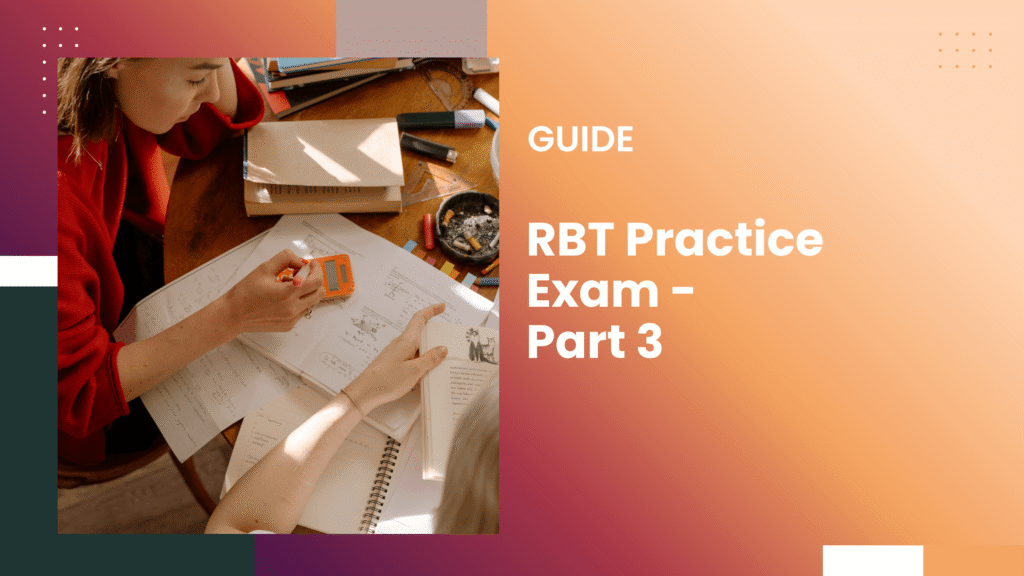
Getting ready for your Registered Behavior Technician (RBT) exam? Try this free RBT practice quiz with 15 selected questions that cover all key domains of the RBT Task List.
You’ll get an instant score at the end with helpful feedback:
- 0 – Need more practice!
- 40 – Keep trying!
- 60 – Not bad!
- 80 – Good work!
- 100 – Perfect!
This quick RBT test is ideal for self-paced study, last-minute review, or identifying areas to focus on. No login required.
RBT Practice Exam
Question 1 |
Discard the previous data and restart the entire observation. | |
Continue using the old definition until the session ends. | |
Note the change in the definition and restart data collection with a new timestamp. | |
Stop the session immediately and consult the BCBA. |
Question 2 |
Try the strategy once, then report to the BCBA. | |
Politely refuse and explain he can only follow approved interventions. | |
Use it only if the caregiver insists. | |
Ask the learner for consent before trying it. |
Question 3 |
Finish the session using whole interval recording. | |
Switch methods but record the time of the change and inform the BCBA. | |
Keep using partial interval but note the request. | |
Discard all data collected and restart the session. |
Question 4 |
End the session immediately and report. | |
Physically intervene to stop the sibling from being hit. | |
Change the intervention temporarily to something less risky. | |
Continue the DRA procedure and collect detailed ABC data. |
Question 5 |
Restrain the client immediately. | |
Create a temporary elopement protocol yourself. | |
Remove the client from danger and inform the BCBA afterward. | |
Call the caregiver to take over. |
Question 6 |
Stimulus generalization | |
Spontaneous recovery | |
Punishment effect | |
Extinction burst |
Question 7 |
Tell the parent you’ll check with the BCBA. | |
Take the videos and send them privately. | |
Let the parent record secretly if they insist. | |
Share the videos but don’t include the learner’s face. |
Question 8 |
Ignore it unless the BACB contacts you. | |
Continue working and assume they’ll catch up next month. | |
Inform your BCBA and document your concern in writing. | |
Ask a coworker to sign off supervision time. |
Question 9 |
Escape extinction can retraumatize if not used carefully. | |
All escape extinction is unethical. | |
You should ignore the history and follow the plan. | |
Reinforcement should replace all punishment procedures. |
Question 10 |
Ignore it unless it’s disruptive. | |
Reinforce it immediately even if not in plan. | |
Punish it since it’s outside the skill target. | |
Collect ABC data and notify the BCBA. |
Question 11 |
Continue with extinction since aggression is the target | |
Redirect the self-injury silently without delivering attention | |
Immediately contact the supervisor and discontinue the extinction procedure | |
Apply punishment as a replacement for extinction |
Question 12 |
Janelle is tracking frequency data for a tantrum behavior but realizes halfway through the session she forgot to record the first three instances. What is the BEST response?
Estimate the missing data and move on | |
Restart the session with new data | |
Document the error and inform the BCBA | |
Leave the data sheet blank |
Question 13 |
A supervisor asks Raj to run a DRA program. Raj notices that the learner’s replacement behavior isn’t actually functionally equivalent. What should he do?
Modify the program to make it equivalent | |
Continue implementing as written | |
Ask the parent to ignore the replacement behavior | |
Pause implementation and consult the supervisor |
Question 14 |
During a session, Ava uses a token economy. The client begins to cry and refuses all tokens, saying they "don't care." What’s the BEST course of action?
Remove the token system and use verbal praise | |
Assess motivation and contact BCBA for alternatives | |
Force the client to earn tokens anyway | |
Switch to edible reinforcers without consulting |
Question 15 |
Reinforce both behaviors equally | |
Only reinforce incompatible behavior if problem behavior is absent | |
Punish the problem behavior after reinforcing | |
Ignore the incompatible behavior entirely |
|
List |
